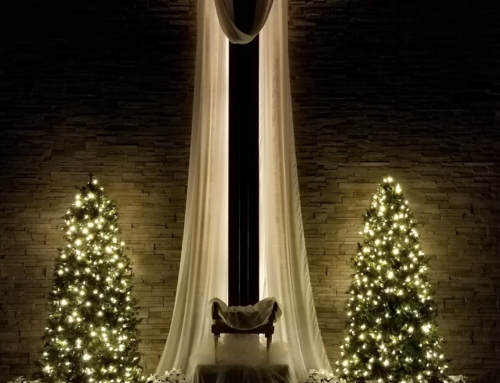
The story is well known. As Jesus and his disciples are travelling along, they meet a man blind since birth begging by the road. The disciples want to know whether the man sinned to become blind or whether his parents did (these are the only two options that occur to them). Jesus says, “Neither this man sinned nor his parents.” Actually, I am the Light of the World and God plans to use this man’s situation to bring God glory. We all have a lot of work to do while I am here.

Then he spits in the mud, makes a mud-cake, and rubs it in the man’s eyes. He sends the man along to wash in the pool of Siloam (which means “sent”) and after having faith and obeying, the man goes home to his shocked family, able to see.
Fast forward, and the whole town is in an uproar. The religious leaders are furious that something like this would happen without their knowing and sanction, and that Jesus would break their religious laws to do it. So they haul the man in, make him tell his story, don’t believe him, have him repeat himself, insult him and ridicule him, and finally fall into the same trap as the disciples, saying “You were steeped in sin at birth; how dare you lecture us!” before throwing him out and rejecting him from religious community.
After the man is rejected by the religious leaders he has a beautiful faith encounter with Jesus. Whereas before his eyes were physically opened, one might say that this is his moment of spiritually “seeing” that Jesus is the Son of Man, the Messiah. After the man worships him, Jesus says,
“For judgment I have come into this world, so that the blind will see and those who see will become blind.” Some Pharisees who were with him heard him say this and asked, “What? Are we blind too?” Jesus said, “If you were blind, you would not be guilty of sin; but now that you claim you can see, your guilt remains.
John 9:39-41, NIV
Headers aren’t included in the original Greek text, but Bible translators and commentators have added titles to this section (from verse 35 on) such as “The Blind Man’s Sight and the Pharisees’ Blindness” (HCSB) or “Spiritual Blindness” (NLT, NIV).
It’s true that at times the Bible uses blindness to depict ignorance, a practice that continues today but is either just tolerated or is upsetting to the disability community. As in any other community, there are diverse opinions on the topic. In a succinct reflection, John Hull remarks,
I lost sight in middle life, and when I read the Bible again, as a blind person, it was very different.
In Matthew 23, for example, Jesus calls his opponents ‘blind fools’. Why not ‘ignorant fools’ or ‘stubborn fools’? Why use my state as a term of abuse? In John 9, the restoration of sight to the man born blind is clearly an allegory of a move from unbelief to faith.
John Hull, “Blind unbelief and blind faith”
While Hull raises some excellent questions, translators and commentators have overstepped in focusing this passage on the Pharisees’ spiritual blindness. Perhaps disability metaphors have become so prevalent that translators, too, read in their own assumptions about “blindness = bad.”
Jesus has said, “For judgment I have come into this world, so that the blind will see and those who see will become blind.” The blind man has just “seen.” Then, the religious leaders assume they are also “blind” in some way and reply, “What? Are we blind too?”
If the translators and commentators are correct, this would be a natural place for Jesus to reply, “Yes, while the man was physically blind you are spiritually blind…” Instead, Jesus says something quite different,
“If you were blind, you would not be guilty of sin; but now that you claim you can see, your guilt remains.”
Jesus again disassociates sin from disability. The Pharisees’ guilt lies with their claim that they can see. In their wrong-sightedness, in focusing on the letter of the law rather than on the law of love that invites everybody to belong, the religious leaders are the ones who are guilty. Both Jesus (Matthew 15:14) and later the Apostle Paul (Romans 2:19) call out judgmental religious leaders for their belief that they can lead others, and yet they are the “blind leading the blind.” Their primary sin is not spiritual ignorance of any kind, but having the pride and the hubris to judge others without first looking to the example of love found in Christ.
In John 9, these leaders were witnesses to the transforming power of Jesus’ love and yet they rejected it for established, legalistic religious systems of oppression. They hadn’t cared for or supported the man when he was beside the road (recalling here the parable of the Good Samaritan), and they didn’t even welcome the man into community after Jesus had helped him conform to their standard of “wholeness.”
Frequently today, we continue to reject the witness and ministry of people with disabilities. We do so as church leaders because we perceive that they need charity and pity, rather than opportunities to minister and lead. We do so because we see that fully including people with disabilities will result in disruption of the “status quo.” In rejecting the witness of disabled siblings, we reject the witness of Christ and instead look to the idols of performance, power, and privilege.
The blind man was transformed from being physically and spiritually blind to full-sightedness and recognizing Jesus as Lord. However, the only healing available for the religious leaders is the path of unseeing – unlearning and tearing down the systems of oppression that have been created to support their own fragile power. The Pharisees weren’t at fault for being “spiritually blind,” needing to find their sight to see Jesus. They are among those who see who will become blind.
This, too, is the path of mercy and the path of redemption. Jesus works through the restoration of sight, but he also works through the taking away of wrong kind of sight. The love of God is incomprehensible and overwhelming. We are unable to achieve or attain it on our own – it can only be received.
Feature Photo by Mishaal Zahed on Unsplash


